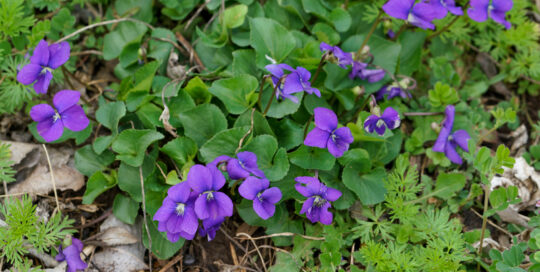Cuphea thrive in summer heat
Views: 4198
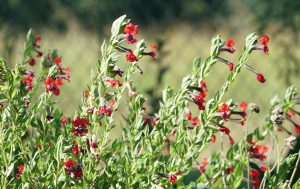
Cuphea is a genus of plants native to the Americas. Most do extremely well in full sun and summer heat as long as they are watered regularly. In most zones they are annuals, but in very southern zones they may be perennial. Hummingbirds, butterflies, and other pollinators will visit them frequently.
You may already be familiar with some species of cuphea: popular plants such as cigar flowers and Mexican heather belong to this genus. The flowers are typically tubular, and sometimes they have shapes that resemble animal faces with big ears, such as bats or mice. These resemblances are often carried into their names, for example, “Bat-Faced” or “Minnie-Mouse” cuphea.
I haven’t planted all the popular cultivars such as Vermillionaire®, but I do have experience with several, and I love them. If my hummingbird feeders go temporarily empty, I know my hummers have other nectar sources they can visit.
I have always planted my cuphea in pots, in regular potting soil. I can’t let them go too long without watering or they’ll wilt, but they bounce back quickly, without damage. Some websites call them drought-tolerant, but that has not been my experience with them, including Mexican heather, but perhaps they do better if they are planted in the ground.
I have over-wintered some species, including cigar flowers, in an unheated, zone 7 greenhouse, but, as a group, I don’t think they are very cold-hardy. However, their heat tolerance and color make them a worthy annual to have.
Here are some that I have planted:
-
Mexican heather
Mexican heather (Cuphea hyssopifolia) – A popular plant for pots and containers, it stays compact, with thin, lacey foliage and small, pink flowers. It thrives in summer, and it needs less watering than some of the others on this list. It must have well-drained soil. Hairstreaks, dainty sulphurs, and eastern tailed-blue butterflies often visit my Mexican heather.
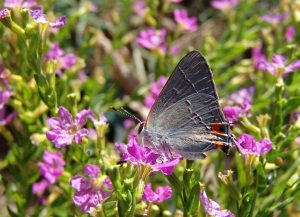
Gray hairstreak on Mexican heather.
-
Bat-faced cuphea
Bat-faced cuphea (Cuphea llavea) – There are a variety of cultivars, but all feature deep red blooms with purple bat-shaped “faces.” I describe this plant as lush, with dark green, draping foliage. Mine stays about 18” tall and about equally wide, but I understand they can get larger if planted in the ground. I have to water this plant regularly. My hummingbirds love this plant’s flowers.
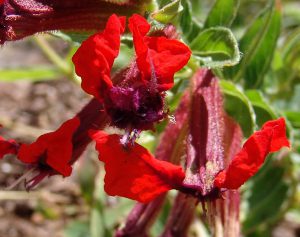
Bat-faced cuphea.
- Cuphea Firefly – I believe this is a cultivar of Cuphea Ilavea, but I am uncertain. They look similar, but Firefly seems bigger: bigger plant and bigger flowers. It is glorious. This is my first year with this plant, but I love it. So do my hummers.
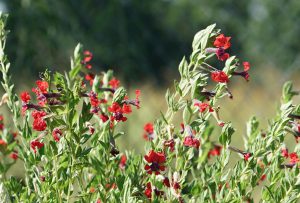
Cuphea “Firefly”
- Cigar flower (Cuphea ignea) – Also called cigar plant, Mexican cigar, and firecracker plant, Cuphea ignea is native to Mexico. It can tolerate part shade. Its tubular flowers are popular with hummingbirds and large sulphur butterflies. I have two cultivars in identical pots, “David Verity,” with red-orange flowers, and “Starfire Pink,” with pinkish flowers. “Starfire Pink” consistently wilts before the other, needing to be watered more frequently. Regardless, both bloom from spring to fall and have overwintered several years in my unheated greenhouse.
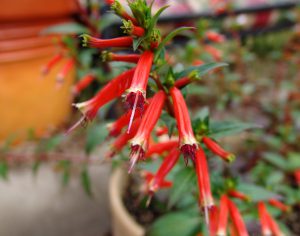
Cigar flower, “David Verity.”
- Cuphea glutinosa – A perennial in zone 7, this cuphea likes to form mats covered in tiny purple flowers. I planted it this spring, and it has done well. I have seen a few skippers on it, but I think the flowers are too small for hummingbirds.
Cupheas are great plants for summer heat. With regular watering, they will provide brilliant color and draw hummingbirds and butterflies to your garden.
Meet Leslie Miller
Leslie Ann Miller shares 3.5 acres in rural Oklahoma with birds, butterflies and wide variety of animals. She is currently transforming her yard with plantings…
Leslie's Recent Posts

Early spring is time to plant native spring ephemerals
